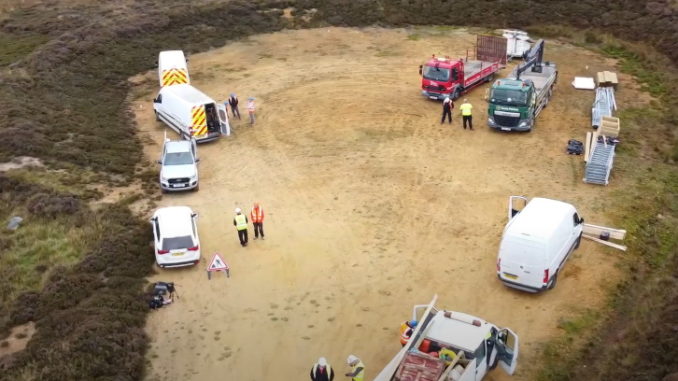
Engineers building a temporary transmitter to replace the mast damaged by fire at Bilsdale say the work will take three weeks.
Operators Arqiva gave the update this morning after work started on the transmitter on Monday.
The company said it was working with environmental experts to protect the site of special scientific interest on the North York Moors to ensure that it quickly built the temporary mast and complied with its obligations to the environment.
Alongside construction work, Arqiva said was consulting with ecologists at the site itself in order to protect the moorland.
Its ecologists have attended site to complete surveys and carry out sensitive habitat clearance in small, discrete sections of the Bilsdale moor.
This work has been completed to ensure the works to construct the temporary mast avoid impacts to the heathland habitats and wildlife, including birds, reptiles and amphibians.
Adrian Twyning, chief of operations at Arqiva, said: “The site at Bilsdale is unique and complex, and we have worked closely with the landowner, Natural England and others to ensure that while we act as fast as we possibly can to build this mast, we do not ignore our clear obligations to the natural environment.”
“Our team is working tirelessly to deliver our recovery plan at Bilsdale, and to date we have been able to return a signal to upwards of 500,000 households using existing and temporary infrastructure around the area usually served by the Bilsdale mast.”
Once operational, the 80m-high temporary mast is expected to provide Freeview TV signals to an area covering over 90 per cent of households which were served by the existing Bilsdale mast, which was damaged by fire on August 10.
Engineers say the build is heavily reliant on helicopter operations and working at height, which makes it weather dependent, and the work is expected to take 21 days to complete.
Arqiva said a “detailed heathland recovery strategy” would be implemented when the temporary mast was removed to ensure that there was no long-term harm to the moorland.
The company said it also wanted to ensure that the project left a lasting legacy benefit for the moors and its wildlife.
The recovery strategy includes re-seeding the heather which is being cleared to make way for the mast base and anchors for the stays — the steel ‘guy ropes’ which will keep the mast upright — and sourcing the correct type of stone to interact with the surroundings.
Floodlights which will allow overnight working in the remote site are solar powered, removing the need for diesel burning generators.


Be the first to comment